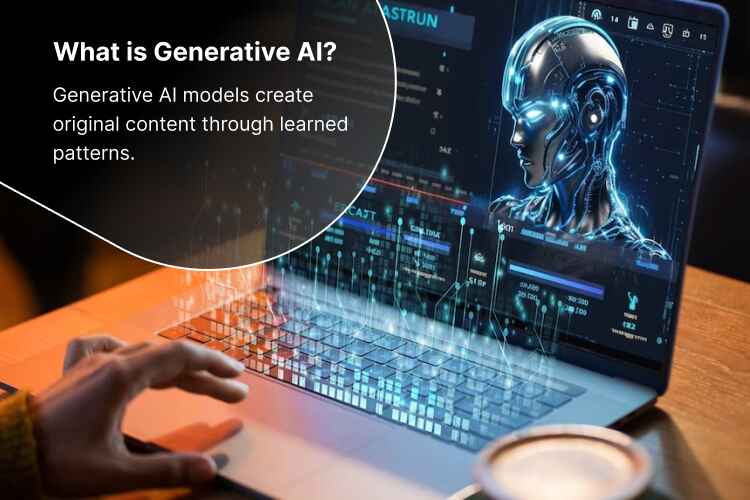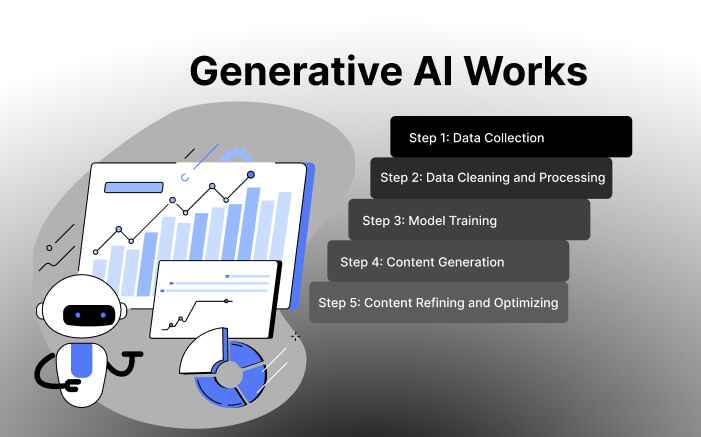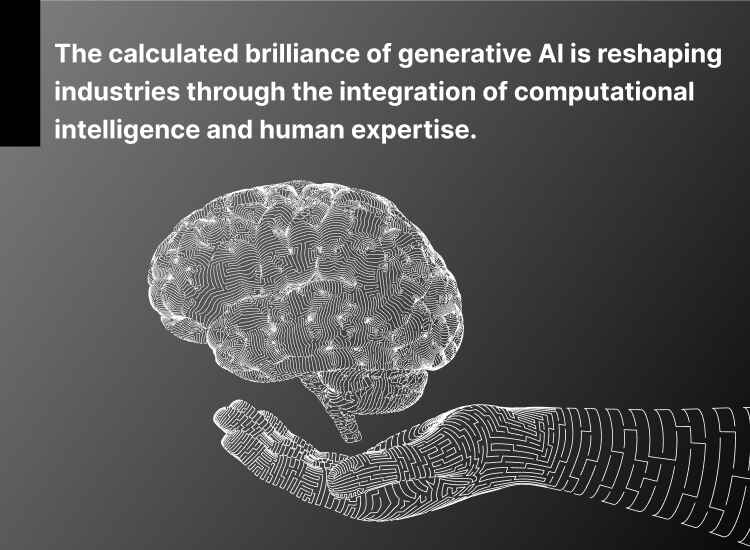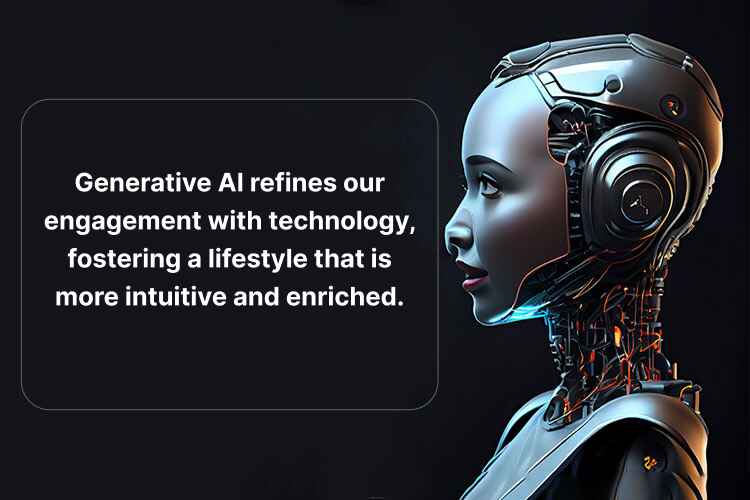What is Generative AI: Applications and Use Cases
- November 26, 2023
- 12 mins read
- Listen

Table of Content
The roots of generative AI can be traced back to the very beginning of AI research. The concept of machine learning emerged in 1950 paving the way for data-based algorithms. Following that, Joseph Weizenbaum develops the first chatbot in history ‘ELIZA’ in the 1960’s. The turning point started in the 2000’s. We are experiencing a massive wave of generative AI-enabled services. Generative AI has marked its footprints in various fields like art, design, healthcare, education, consulting, and more.
Let’s get into the details of what is generative AI, use cases, applications, and risk factors.
What is Generative AI?
“Generative AI is not just about copying the world; it’s about understanding the world and using that understanding to create new things.” – Demis Hassabis, DeepMind, co-founder
Generative AI is a deep learning model that facilitates raw data samples to self-train and produce new data based on user inputs. It can create new conversations, images, music, video, and many more creative generative results. Let’s break it down for you to understand better,

Artificial Intelligence: AI or artificial intelligence is a machine-powered algorithm that is trained to perform functions associated with the human mind faster and more precisely. It collaborates with data sources and mimics human intelligence to produce content that resonates with human behavior.
Generative AI: Now, generative AI is one step ahead of AI (artificial intelligence). AI goes deeper into generative AI. Generative AI can be considered a specific application of AI. It utilizes many of the same underlying techniques and algorithms but with a distinct focus on content creation. It does not simply mimic user inputs like the previous artificial intelligence model. Generative AI can produce absolute raw and new content.
How Does Generative AI Work?
“Generative AI has the power to unlock new forms of human expression and creativity. It will push the boundaries of what’s possible and help us imagine and build a better future.” – Satya Nadella, Microsoft CEO
Generative AI produces data through the use of models that are trained on large datasets. These models, often based on neural networks, learn patterns and relationships within the data they are exposed to during the training process. Once trained, generative AI can generate new data samples that mimic the patterns of the original dataset.
Example:
Let’s consider a generative AI model trained on a dataset of handwritten digits (0-9). During training, the model learns the features and variations present in the dataset. Once trained, it can generate new, realistic-looking handwritten digits that were not part of the original dataset.
For instance, if the model encounters a sample of the digit ‘8’ during training, it learns the typical strokes, curves, and variations associated with the digit. After training, the generative AI model could then produce new, synthetic examples of the digit ‘8’ that were not present in the original dataset.
In summary, generative AI produces data by learning and replicating patterns from the input dataset, enabling it to create synthetic data that resembles the original and can be used for various applications, including image generation, text completion, and more.
Here’s a step-by-step breakdown:
Step 1: Data Collection
The first step is data collection. Generative AI gathers massive datasets from the existing content in the desired domain.
The data collection process runs on a variety of sources including books, articles, websites, social media posts, and anything available in the cloud. Data preparation and cleaning are the crucial focus at this step.
Step 2: Data Cleaning and Processing
The generative AI model then identifies and collects relevant data from various sources. To bring you the best answer from the prompt, it cleans data and arranges it into a format. The process may involve converting various file formats, aligning timestamps, and ensuring proper structure.
Then, the data goes through a few more cleaning processes like noise removal, bias detection and mitigation, consistency checks, and validation.
Step 3: Model Training
Now the actual magic begins! Here, a specific type of AI model, often a deep learning model like a neural network, is chosen.
This model is fed the prepped data and starts learning its subject matter. It analyzes patterns, relationships, and statistical probabilities within the data, understanding how words connect, images are structured, or music unfolds.
Training involves feeding the model the data repeatedly and fine-tuning its internal parameters through algorithms like backpropagation to minimize errors and improve its learning.
Step 4: Content Generation
“Generative AI is the future of content creation. It will democratize the ability to create high-quality content, making it accessible to everyone.”- Andrew Ng, Landing AI founder
Once trained, the model is ready to create! You provide it with a prompt or seed, which can be a text phrase, an image sample, or any relevant input in the chosen domain. The model then leverages its previously learned knowledge to generate new content.
This generation process can be iterative, with the model refining its output based on feedback or additional inputs. It leads to increasingly personalized results.
Step 5: Content Refining and Optimizing
Generative AI isn’t a one-and-done process. The models and generated content are constantly evaluated for accuracy, quality, and desired originality. If you make even minor changes to your prompt, generative AI might produce very different results compared to the previous.
Techniques like human validation, comparison with ground-truth data, and error analysis are used to identify areas for improvement. Based on these evaluations, the model can be further trained with additional data or adjusted in its parameters to generate better outputs over time.
Generative AI Applications and Examples
“Generative AI is still in its early stages, but it has the potential to revolutionize many aspects of our lives, from the way we create art and music to the way we design products and develop drugs.” – Jeff Dean, Google Senior Fellow, and Chief AI Scientist
The application of generative AI is diverse and it’s rapidly growing with new inventions. Here’s an explanation of 8 generative AI applications across various domains:

1. Text Applications
The use of generative AI in text applications is the most commonly adopted application. This usage includes generating articles, blog posts, social media content, emails, marketing copy, product descriptions, scripts, code, emails, letters, poems, code, scripts, musical pieces, emails, letters, etc.
Some more variants include translating text from one language to another accurately and efficiently. You can also use generative AI text applications to summarize long texts into shorter summaries.
Tools: Jasper, Writesonic, Copy.ai, Sudowrite, Rytr, Copysmith
2. Conversational Applications
These applications use advanced natural language processing and machine learning algorithms. For example, they use GPT-3. They generate human-like responses and engage users in dynamic, relevant conversations.
These applications closely mimic human communication. They can provide personalized and context-aware interactions across various domains. These include customer service, virtual assistants, and interactive content creation.
Chatbots are considered primarily conversational AI applications as they are designed to simulate conversation with humans, understand user input, generate responses, and maintain context throughout the interaction.
Tools: Bard, Kore, Cohere Generate, Avaamo, Yellow AI, Fireflies
3. Visual Applications
This advanced artificial intelligence can transform creative fields as well. It generates realistic images, artwork, and designs from textual descriptions or abstract concepts. This technology extends its reach to video generation. It enables the creation of videos with lifelike visuals and animations. This opens up new possibilities in the realm of digital content creation.
Additionally, generative AI plays a crucial role in photo editing. It offers tools to enhance images, remove imperfections, and apply artistic effects. This contributes to the refinement of visual content.
Tools: Midjourney, DALL-E, Synthesia, StyleGAN, Canva, Nightcafe
4. Audio Applications
Generative AI promotes advancements in AI-powered audio generation. This includes converting speech to text for documentation, accessibility, and searchability. Audio applications also include composing original music pieces in various styles.
It sets you all free from complex software usage. Moreover, the time-consuming process of audio generation is now faster than ever. Thanks to generative AI.
Tools: AudioCraft, Play.ht, Otter.ai, Transcribe, Murf.ai, Soundraw
5. Customer Service Applications
This is another application that has tremendously utilized generative AI. Many customer engagement platforms incorporate AI-enabled services. It helps provide automated support and answer customer queries effectively.
Several companies and industries can provide 5X enhanced customer services. Generative AI-supported chatbots offer personalized recommendations and solutions based on individual needs. This results in higher customer satisfaction.
Tools: REVE Chat, Zigpoll, Yuma AI, MeyaGPT
6. Personalized Learning Applications
Personalized lessons improve the effectiveness of education. Generative AI tools can help to design personalized courses and lesson plans. The education comes paired with technologies making learning more fun.
Generative AI can also help teachers in preparing their sessions better. For example, they can prepare quizzes, exercises, or questions for exams. They can prepare tailored study guides for individual students.
Tools: Duolingo, Mondly, ELSA Speak
7. Software Coding Applications
Generative AI has also revolutionized the field of software coding. It offers innovative approaches to streamline and automate the development process. Developers can use natural language interfaces to interact with the code. For example, with models like GPT-3. This enables a more intuitive and efficient coding experience.
Generative AI helps generate code snippets and automate repetitive tasks. It can even propose solutions to complex programming challenges. This technology has the potential to enhance collaboration among developers. It can understand and generate code in various programming languages.
However, developers need to remember that this may not produce flawless code. Thus, it will need their major involvement in software coding.
Tools: ChatGPT, Auto-GPT, GitHub Copilot, AlphaCode
Generative AI Use Cases
AI has been part of every growing sector in recent years. Generative AI is growing fast replacing more creative forms of mundane tasks. The new disruptive opportunities are making industries grow and improve productivity. Let’s look at some use cases,

1. Healthcare Facilities
Previously, the healthcare industry faced several challenges to streamline its tasks. Generative AI came up with various solutions to assist healthcare industries in boosting their productivity. Some generative AI-backed healthcare facility task involves,
- Designing new molecules for targeted therapies and predicting their effectiveness.
- Tailored treatment plans based on individual genetic data and medical history.
- Automating diagnosis and disease detection at early stages.
- Supporting doctors and nurses with scheduling appointments, managing patient records, and answering FAQs with the help of virtual assistance.
2. Consulting Services
Consultancies can involve generative AI in more than one way. It helps make reports adjustable and information representation reports for organizations in addition to other things. It also empowers data-driven insights. Structured data enables consultants to be more confident about their decisions. Some more benefits are,
- Preparing tailored proposals to specific client needs and preferences.
- Creating simulations for analyzing potential outcomes and mitigation strategies.
- Summarizing complex information and automating report writing.
3. Retail Sector
In retail generative AI emerged as a ground-breaking technology. It has simplified ground operations, automated regular tasks, and assisted creative sides. Imagine having a shopping experience so good that you get back to the same retail every time. Generative AI can create such experiences for retail sectors.
- Generating customized product recommendations and offering unique design options.
- Predicting demand and managing stock levels to avoid product shortages.
- Optimizing pricing strategies based on market trends and customer behavior.
- Creating personalized marketing campaigns and chatbot interactions.
4. Travel Industry
The travel industry is booming in 2024 and travelers are looking forward to having unparalleled travel experiences. This industry is heavily using generative AI to take travel and tourism one step ahead. Whether it’s an AI-powered travel assistant or booking assistance, generative AI is all on board to create memorable travel experiences.
- Suggest tailored itineraries and experiences based on user preferences.
- Optimizing pricing based on real-time demand
- Generating itineraries and booking flights, hotels, and activities.
- Answering customer questions, providing recommendations, and assisting with bookings with virtual travel assistance.
5. Marketing
Generative AI has been very promising to marketing sectors. From content to visual creation, AI is everywhere. Traditional marketing used to rely on human predictions. Marketers had to handle many time-consuming tasks manually. Generative AI has automated many of those monotonous tasks.
- Creating catchy ad copy, product descriptions, and marketing materials.
- Generating engaging posts and tailoring content for different platforms.
- Targeting specific customer segments with tailored messaging.
- Analyzing customer data to predict behavior and personalize marketing strategies.
6. Supply Chain
Supply chain management can also leverage generative AI. It trains supply chain data to provide accurate information. It facilitates the automation of routine tasks, freeing human resources for more strategic decision-making. The only challenge faced is the supply chain business model. Overly complex models lack transparency which might hinder AI-driven insights.
- Planning efficient routes and schedules for transportation and delivery.
- Identifying potential equipment failures and scheduling preventative maintenance.
- Accurately predicting product demand to optimize inventory and production.
- Identifying anomalies and potential fraud in supply chain operations.
7. Customer Support and Services
Conversational AI is the most commonly used generative AI in customer services and contact centers. It helps to improve real-time interaction. Chatbots have been revolutionary for these industries. Customer services can leverage both live chat and chatbot technology to provide a seamless experience.
- Providing 24/7 support, answering questions, and resolving simple issues.
- Understanding customer sentiment and identifying areas for improvement.
- Tailoring interactions to individual customer needs and preferences.
- Predicting potential problems and proactively addressing them before they impact customers.
The Risks of Generative AI
As generative AI brings us into the future where machines mimic human creativity, the landscape is both promising and precarious. The risks associated with thing technology cannot be ignored. There is a high risk that people can use generative AI for malicious purposes. We already have examples including deepfake videos, fake news, and other forms of misinformation.
As the system can reproduce from existing data. This raises concerns about exposing sensitive data and confidential details. There is also the risk of adversarial attacks. A slight modification to input data can lead to unexpected and potentially harmful outputs.
Generative AI systems are becoming more complex. Understanding how and why certain decisions or outputs are generated can be challenging. This lack of transparency can make it difficult to hold the system accountable for its actions.
End Note
Generative AI is increasingly becoming popular. It incorporates our regular lives and many industry sectors to fine-tune the task process. All we need is to recognize the best uses of generative AI and minimize risk factors. Striking a balance between innovation and responsibility is important to utilize the full potential of generative AI. It’s indeed a powerful tool.
